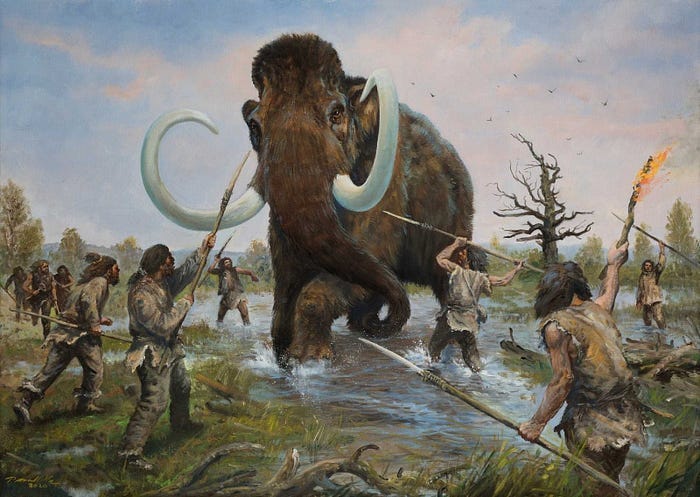
Some 28,000 years ago, a little girl and her family sat around a fire by a stream in Moravia, Czechia, as the winds howled. Gathered around the warmth, they braved icy temperatures to make clay figurines of the creatures they encountered. The sculptures were mostly of megafauna, such as woolly rhinoceros, cave lions, bears, and mammoths. They also featured foxes, owls, and horses.
One figurine stood out.
It was a tiny, featureless female figure with enormous breasts, hips, and a round tummy. The child gazed at it in amazement before her parents hurriedly took it away and threw it into the fire. It was one of several human and animal figurines that these mysterious people had crafted that night.
On July 13, 1925, archaeologists led by Karel Absolon excavated the Dolní Věstonice site in Moravia. Next to lumps of clay by a fireplace, they found animal figurines and a shattered, curvaceous statuette covered in ash.
The faceless figurine’s bulging breasts, wide hips, and distorted arms and legs left the excavators scratching their heads. What was the meaning of this object with odd proportions?
Or did people look like that back then?

Absolon and his colleagues discovered the world's earliest known ceramics and unearthed the first permanent human settlement, Dolní Věstonice, dating back approximately 27,000 years ago. People here didn’t just survive the bitter-cold Ice Age; they thrived.
The discovery leaves us with more questions than answers.
How did humans struggling for survival during the Ice Age produce ceramics long before inventing pottery? Was there a specific class of people committed to creating such excellent art? Where did they get the food security to do so?
Our understanding of human history is often linear.
We imagine ancient humans as hunter-gatherers who started farming and building cities after the Last Ice Age ended 12,000 years ago. These urban landscapes grew into civilizations, nations, and eventually empires.
But the reality is much more complex.
The journey to civilization involved several starts and stops. Settled life began even before the discovery of farming. In some regions, such as the Americas, animals were domesticated long before agriculture was established, while in others, like Japan, pottery was invented before humans started cultivating crops.
Our path to evolution and modern life resembles multiple branches of a tree connected by a stem and roots. One notable branch was observed in the Moravian basin, where hunter-gatherers during the Ice Age formed a settled community long before farmers from Anatolia introduced agriculture to the region.
The Gravettians made the exquisite ceramics at Dolní Věstonice. They were descendants of the first humans to colonize Europe and laid the groundwork for civilization that blossomed thousands of years later.
This story is a two-part series about the enigmatic lords of the mammoth steppe, the Gravettians. In today's edition, we will explore their origins, diet, lifestyle, and how they buried their dead. The second part will focus on the mysterious Venus figurines, the most renowned artistic representations of the Ice Age.
Origins of the Gravettians
The Gravettians were hunter-gatherers who lived in Europe and Russia between 33,000 and 21,000 years ago. This period is called the Upper Paleolithic or Old Stone Age.
About 57,000 years ago, the earliest known human settlers arrived in Europe. They interacted and interbred with Neanderthals. These early Homo sapiens are referred to as Early European Modern Humans, but you might recognize them by their more popular name: Cro-Magnons. This name comes from the Cro-Magnon cave in France, where they were first discovered.
The descendants of the Cro-Magnons established the Auragnacian culture, the earliest widespread archaeological technocomplex. In archaeology, the type of stone tools discovered defines a technocomplex.
Though no two culture sites were identical, a general commonality was noticed during the Auragnacian period, which lasted from 43,000 to 28,000 years ago.
There was a slight overlap between the Gravettian and Auragnacian epochs.
The Gravettians trace their ancestry back to the Aurignacians. A 2023 study that analyzed 356 hunter-gatherer genomes from 116 ancient skeletons across 14 countries in Central and Western Eurasia found a connection between the Gravettians and the earlier Aurignacian populations. Additionally, the researchers discovered that the Gravettians in Western Europe were genetically distinct from those in Central and Southern Europe.
The following figure shows that those who lived at Dolní Věstonice were a mixture of Eastern(Kostenski, Russia) and Western( Goyet, Belgium) Auragnacian groups. However, the DNA revealed that Věstonice people were more related to the Eastern Auragnacian group than the Western one.

Earlier this year, researchers from the University of Bordeaux, France, conducted another study and found that nine separate cultures existed across Eurasia during the Gravettian period. Although we consider the Gravettians a single group, their cultural traditions were diverse.
So, why are they called “Gravettians?”
What did they have in common?
Keep reading with a 7-day free trial
Subscribe to Forgotten Footprints to keep reading this post and get 7 days of free access to the full post archives.

